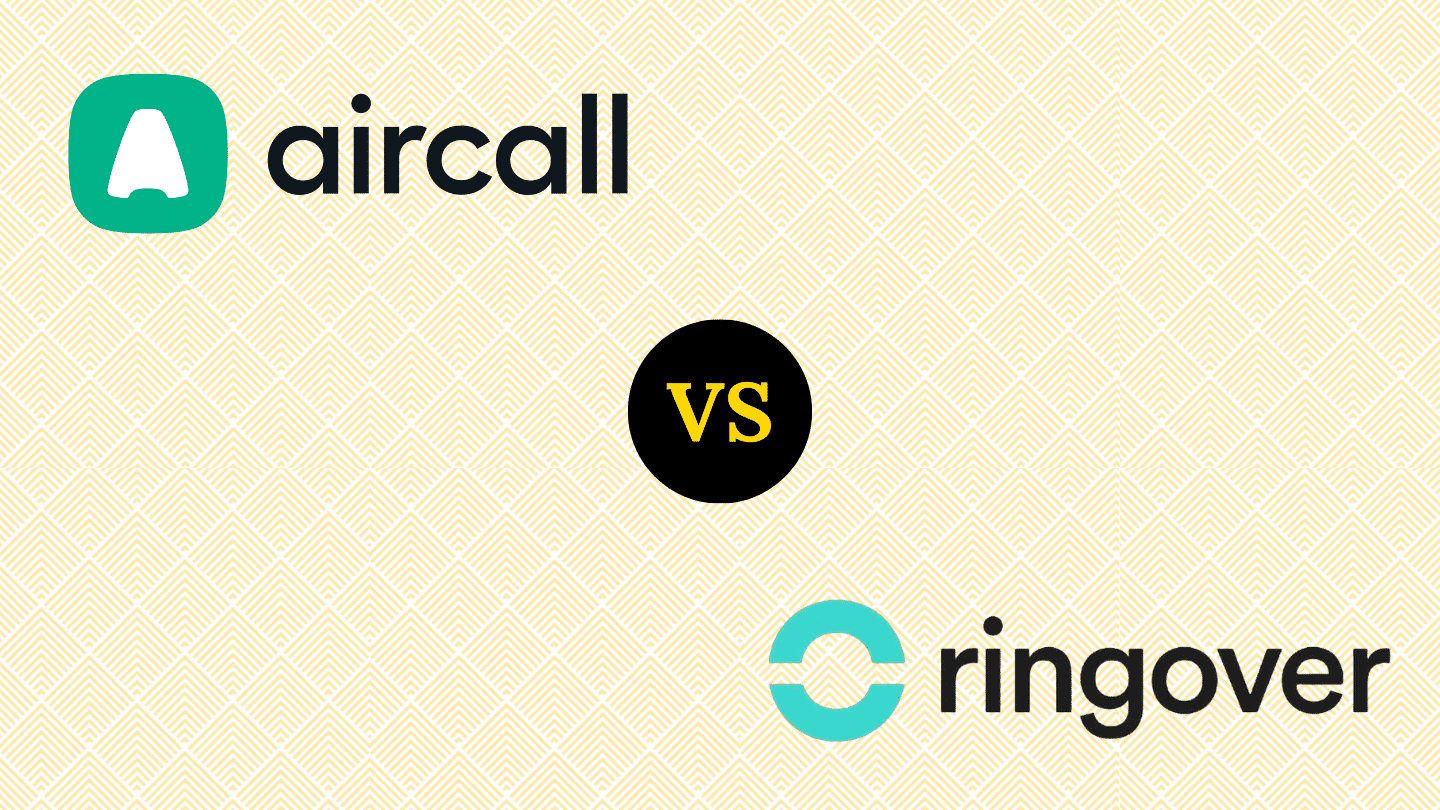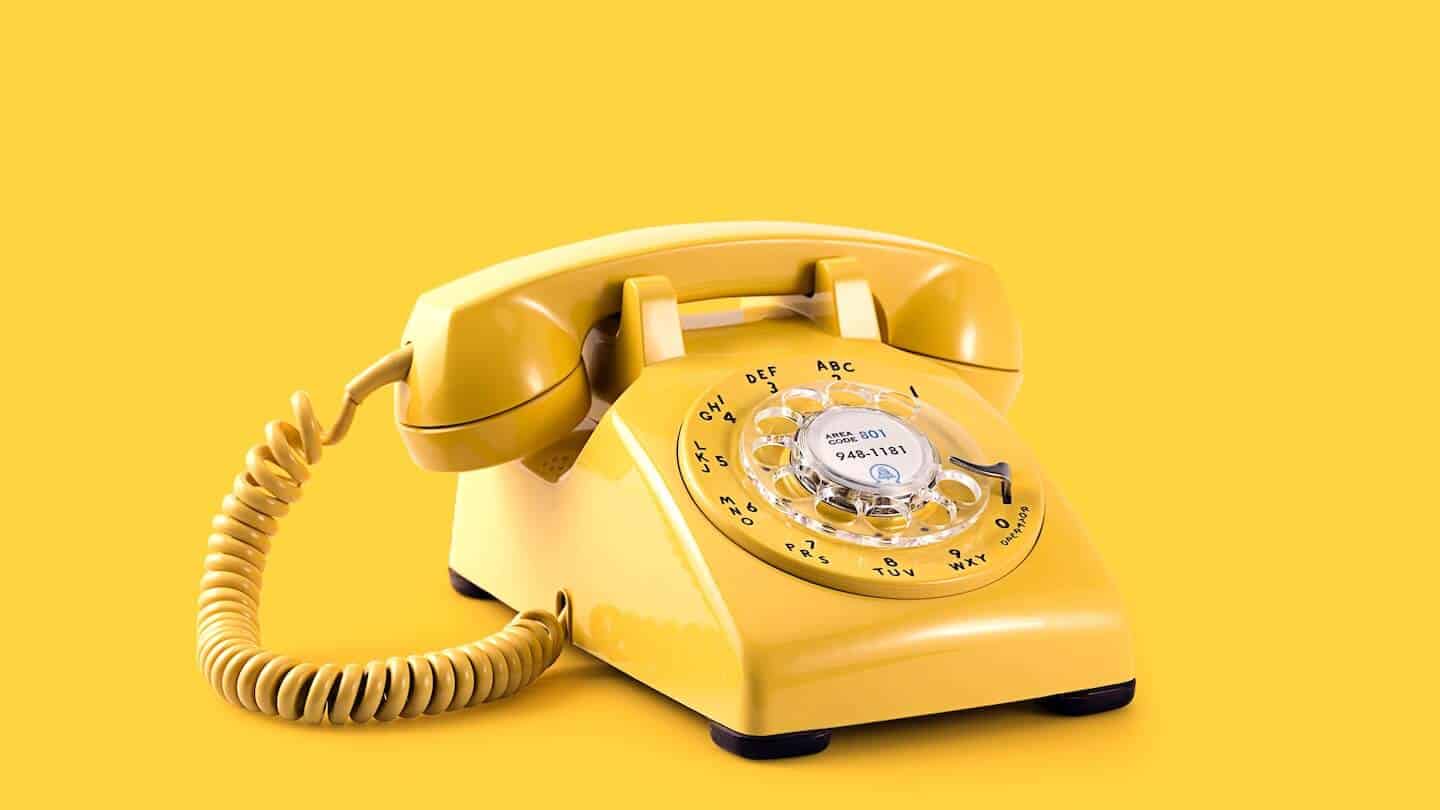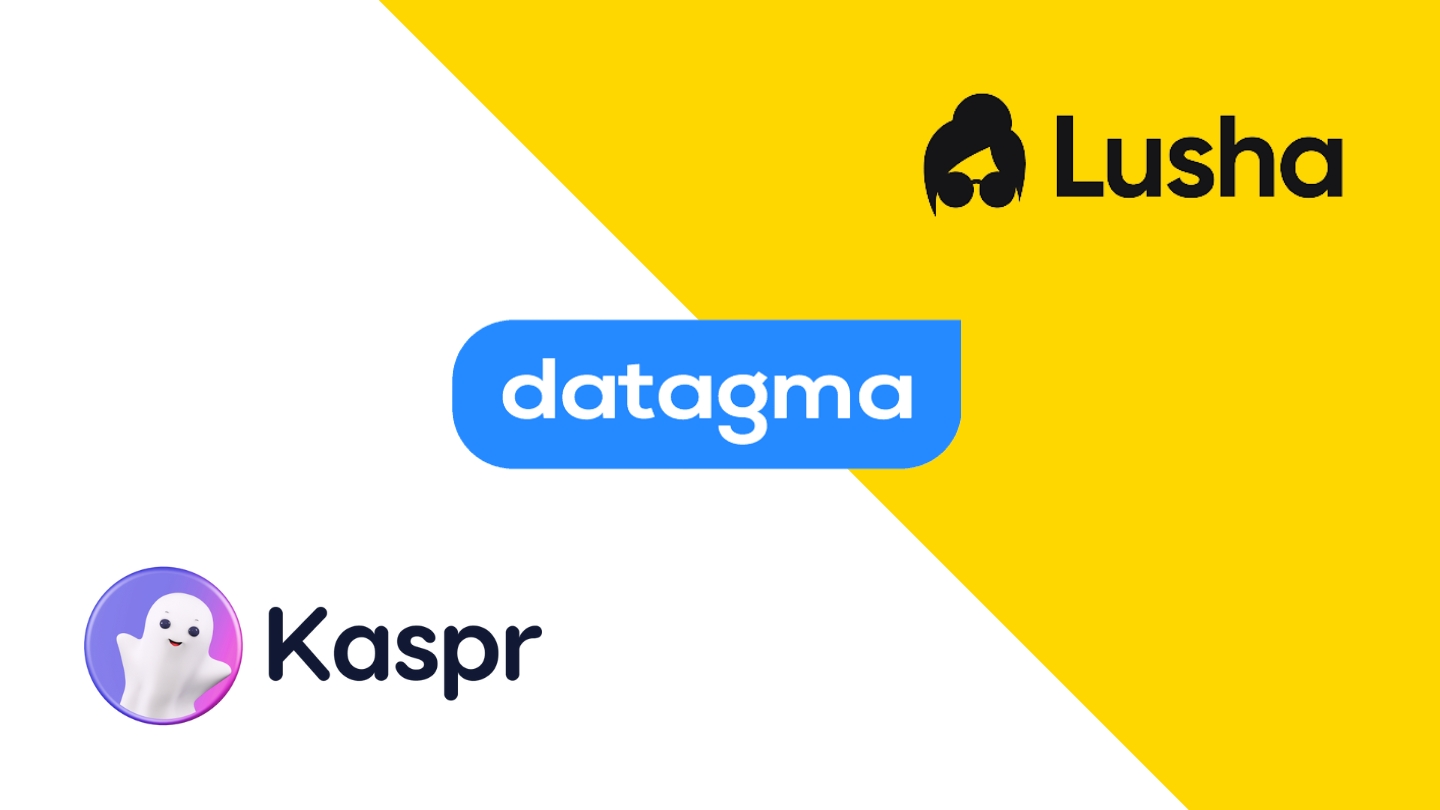In 2020, cold calling is still a very effective way to make contact with a prospect. Indeed, no less than 69% of buyers have accepted a call from new salespeople in the last 12 months. But that’s not all: 75% of prospects in various industries have attended an event or scheduled a meeting because of unexpected cold calls. In this article, we will help you make your cold calling more effective. First, we’ll give you some statistics to help you diagnose your cold calling campaigns and then we’ll distill some impactful tips to make your cold calling more effective.
Sommaire
Your cold calling doesn’t pay as much as it should
Have you started cold calling but the results are slow in coming? Here are some tips to avoid the same mishaps:
It is not strength, but perseverance, that makes great works
One of the reasons why salespeople fail on cold calls is that they give up too easily. Most of them are not prepared to try again in a different way.
- 92% of sales professionals give up after four ‘no’s’, but 80% of prospects say ‘no’ four times before saying ‘yes
- 44% of salespeople give up after one follow-up call
- It takes an average of 18 calls to connect with a buyer
- On average, salespeople make no more than two attempts to obtain a lead through cold calls
Success is never easy to achieve; even Henry Ford suffered business losses and went bankrupt. But such failures did not deter him from trying again and creating one of the most successful car companies in the world. If you don’t give yourself a fair chance, then it will be difficult to make successful cold calls. Prospects will not easily trust an unknown caller. As a salesperson, you have to make an effort and gain their trust. Cold calls require patience, perseverance and multiple attempts to get positive responses and longer term prospects.
“Success is achieved and maintained by those who try and keep trying” – W. Clement Stone
Prepare your calls better
Another reason for the failure of cold calls is the lack of research. Without proper research, you can’t personalise your sales calls. And personalization is a must to engage and keep prospects on the line as long as possible. It is necessary to research prospects and gather information before calling them.
- 42% of salespeople think they do not have enough information before calling a prospect
- 82% of B2B decision-makers believe that salespeople are not prepared
Look at their website, relationships, customer reviews and social media pages to gather relevant information about them. Note their achievements, business weaknesses and common interests that you can discuss on the call.
Poorly qualified prospect bases
If you have taken the wrong road, you will never reach your destination. Good prospecting data is vital for successful cold calls. Without it, you will struggle to reach high-potential sales prospects. You simply can’t call everyone. Refine your research and improve the quality of your data for better cold calls.
- Inaccurate contact data in your B2B CRM software wastes 27.3% of sales professionals’ time. That’s about 546 hours per year for a full-time salesperson
- 94% of companies believe their customer data is inaccurate or incomplete
- 88% of companies reported that inaccurate data has a direct impact on the company’s bottom line, with the company losing, on average, 12% of its revenue.
- 88% of buyers have mostly nothing to do with cold calls
- Poor data costs US companies over $611 billion a year
Avoid wasting valuable hours and audit your phone list to ensure you are targeting the right buyers. Once you have collected the right contacts, use a contact management tool to organise them in one place.
And yet, cold calling works well. In fact, 69% of buyers have accepted a call from new salespeople in the last 12 months. Not quite convinced yet? 75% of prospects in various industries have attended an event or scheduled a meeting because of unexpected cold calls.
But then, how can we do better?
1. Do not accept to hang up for 5 minutes
Once the buyer has answered your call, you have 5 seconds to save 5 minutes. Successful cold calls are almost twice as long as unsuccessful cold calls. The longer the sales call, the more likely you are to get a meeting to demonstrate your product/service.
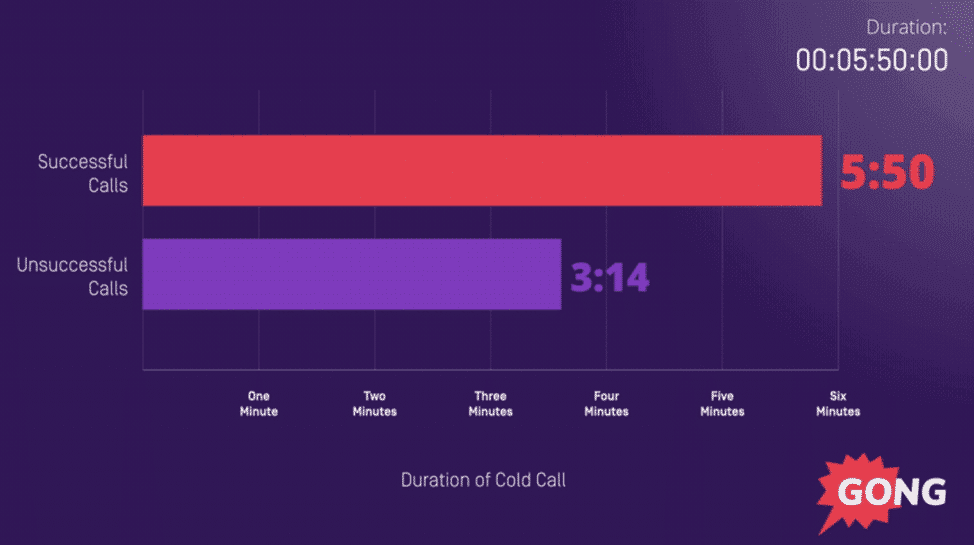
Your job is not just to get your prospect’s attention during a cold call, but to keep it throughout the conversation. And here’s your advantage: you’ve made that same cold call hundreds of times. You can predict the conversation “paths” and how to navigate them. You have the power to plan every move you make in advance.

Each sentence you say should lead the buyer to listen to the next. This means that your script must be economical and convincing. Here’s how to be economical: imagine you get £100 every time you remove any unnecessary words from your sales conversation.
2. Don’t say: I’m not disturbing you?
This is a common way for new salespeople to open a cold call. “Hello John, this is Peter from Salesdorado, I hope I’m not disturbing you?” This phrase is recommended by many sales books. But, the theory is that people like to say “no” to feel in control. And when you ask, “I hope you don’t mind” on a cold call, they mean “No.” It opens the door to a successful cold call. You like the theory, don’t you? But, according to Gong.io‘s analysis, opening your sales process with “Do not disturb” gives you a 40% lower chance of getting an appointment:
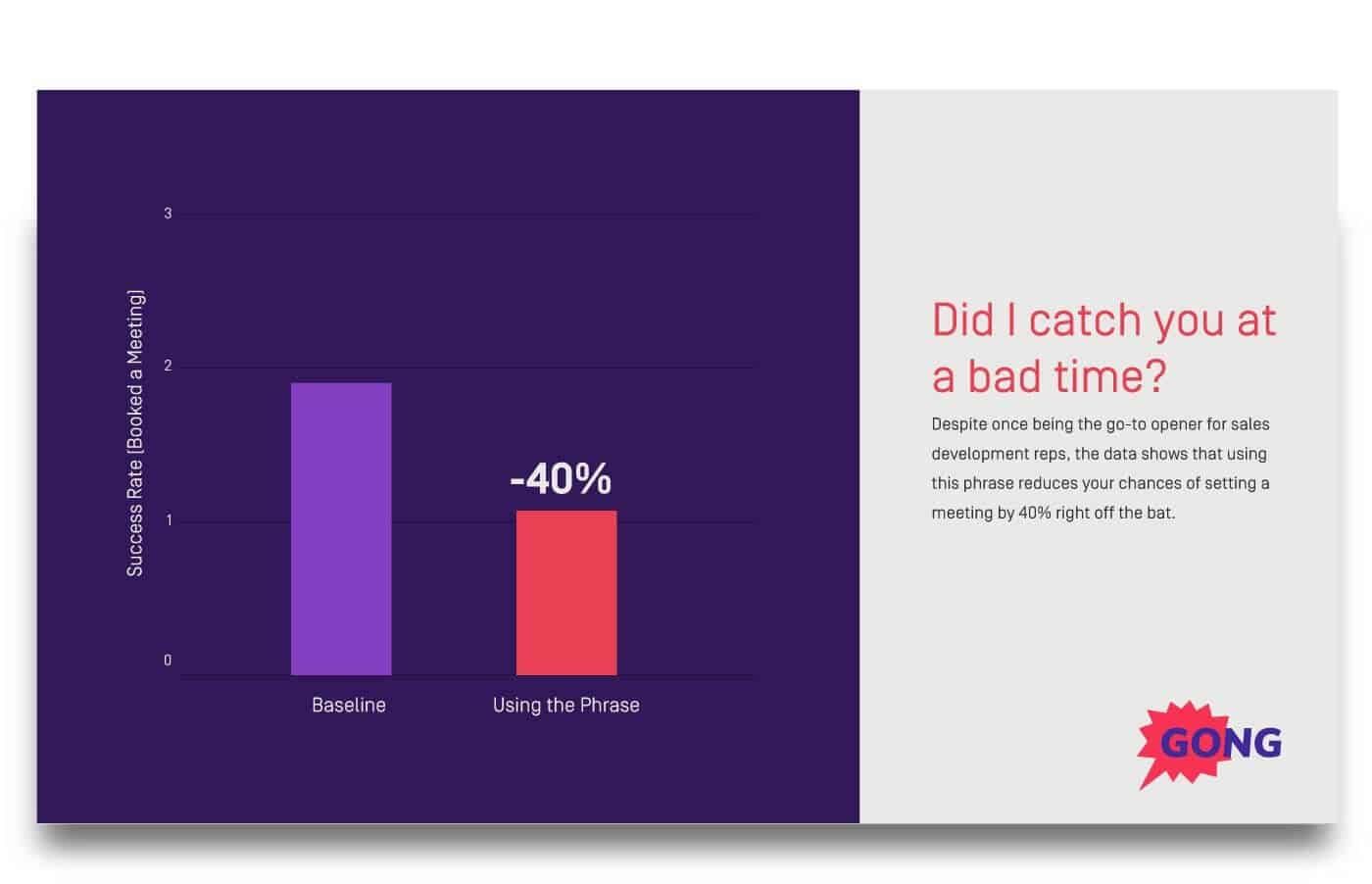
The cold calls that opened with this line had a dismal success rate of 0.9%.
3. Say: How are you?
According to data from 90,380 cold calls collected by Gong.io, one catchphrase is much more effective than the others, and that is the famous “How are you?” It achieved a success rate 6.6 times higher than the norm:
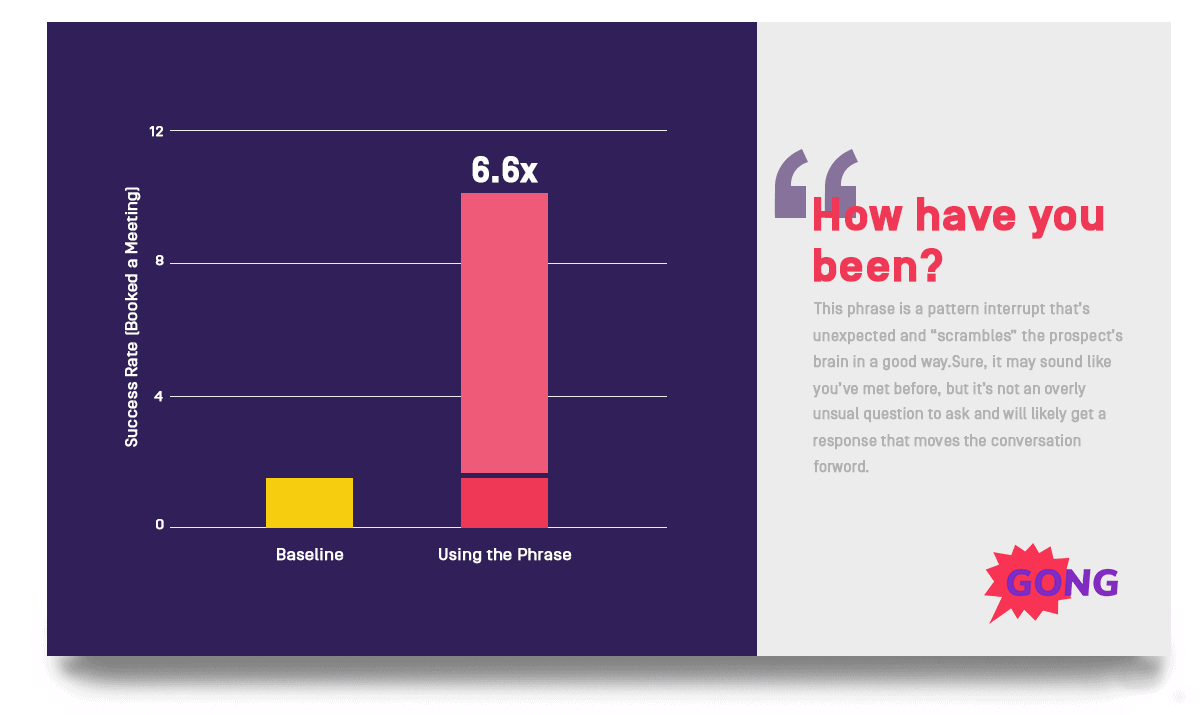
Cold calls using this question had a success rate of 10.01%. You may think there has been a previous interaction. “How are you?” implies that there was a previous interaction. But that’s not the case – the data set was exclusively first interactions (hence the term “cold call”). So why does this question work so well? It’s an unexpected question that scrambles the potential customer’s brain (in a good way). Even if you have never spoken to the person before, you can ask this question naturally to a complete stranger.
4. Start with the reason for your appeal in a transparent way
Starting your call with the reason for the call increases your success rate by 2.1X:
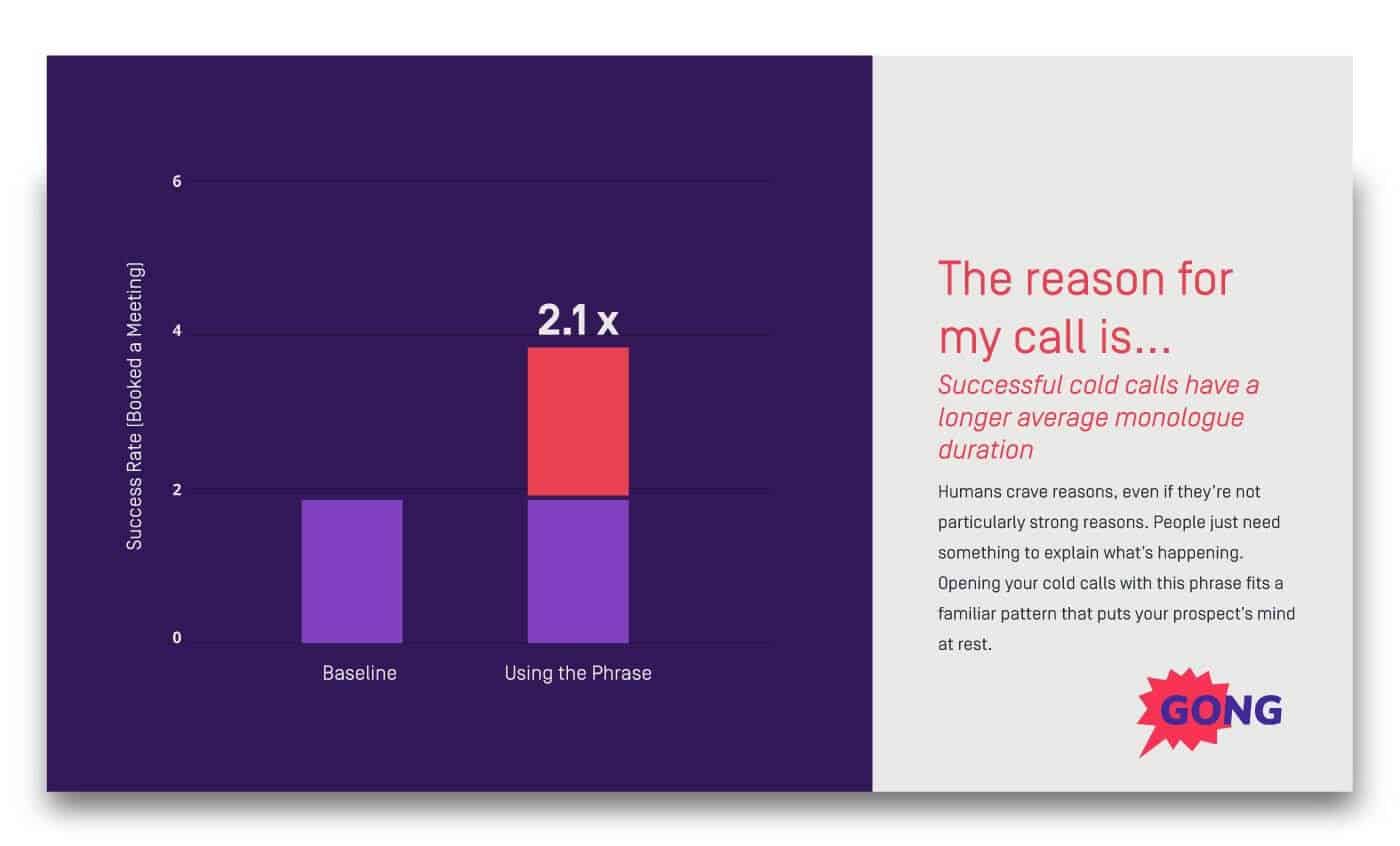
People want to know why you are calling them, even if it is not important to them. So here’s what your cold call script might look like so far:
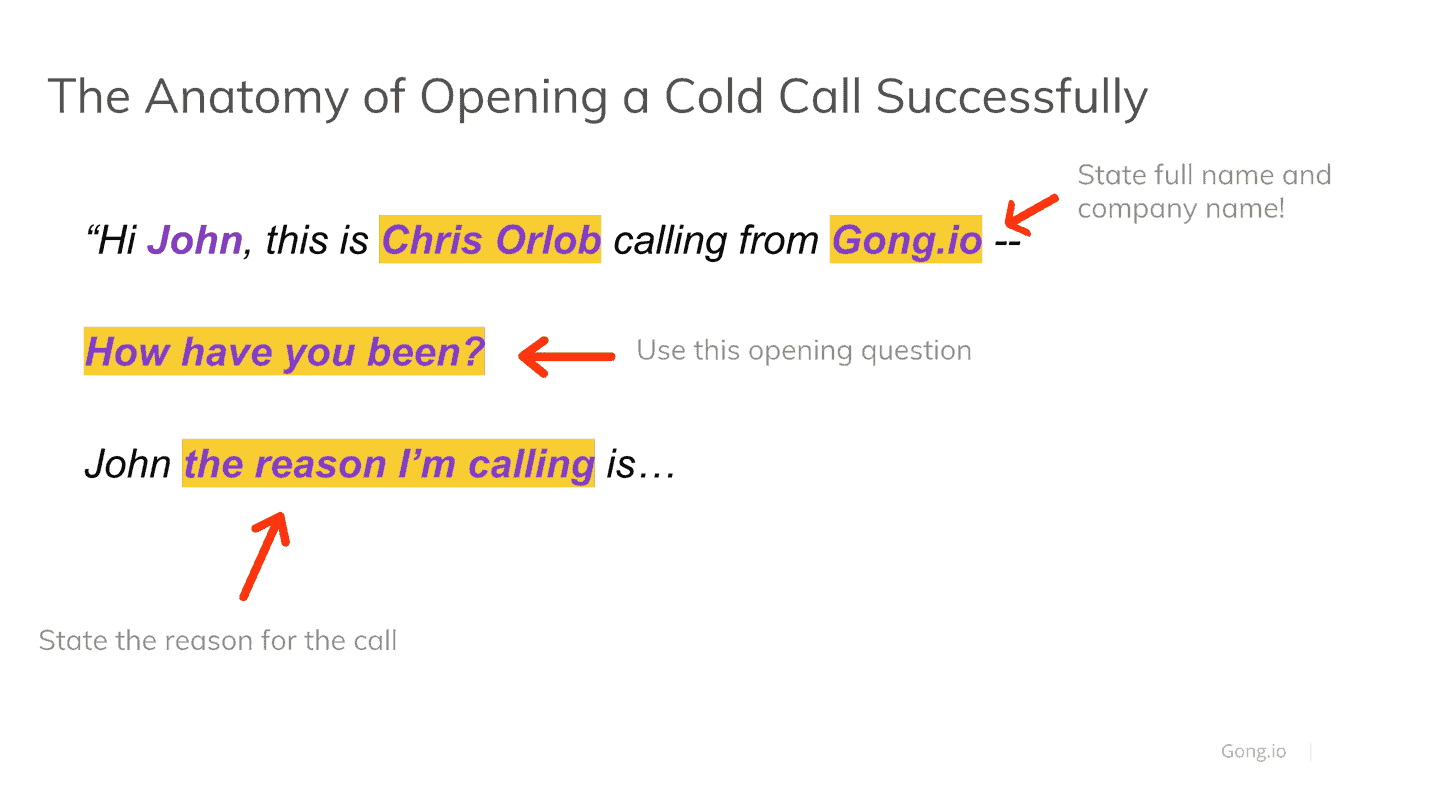
5. You don’t call to qualify, you call to sell an appointment
“Listen twice as much as you talk” does not apply to cold calls. Cold calling is not about discovery, it’s about selling an appointment. In fact, the ratio of successful cold calls is higher when you talk than when you listen:
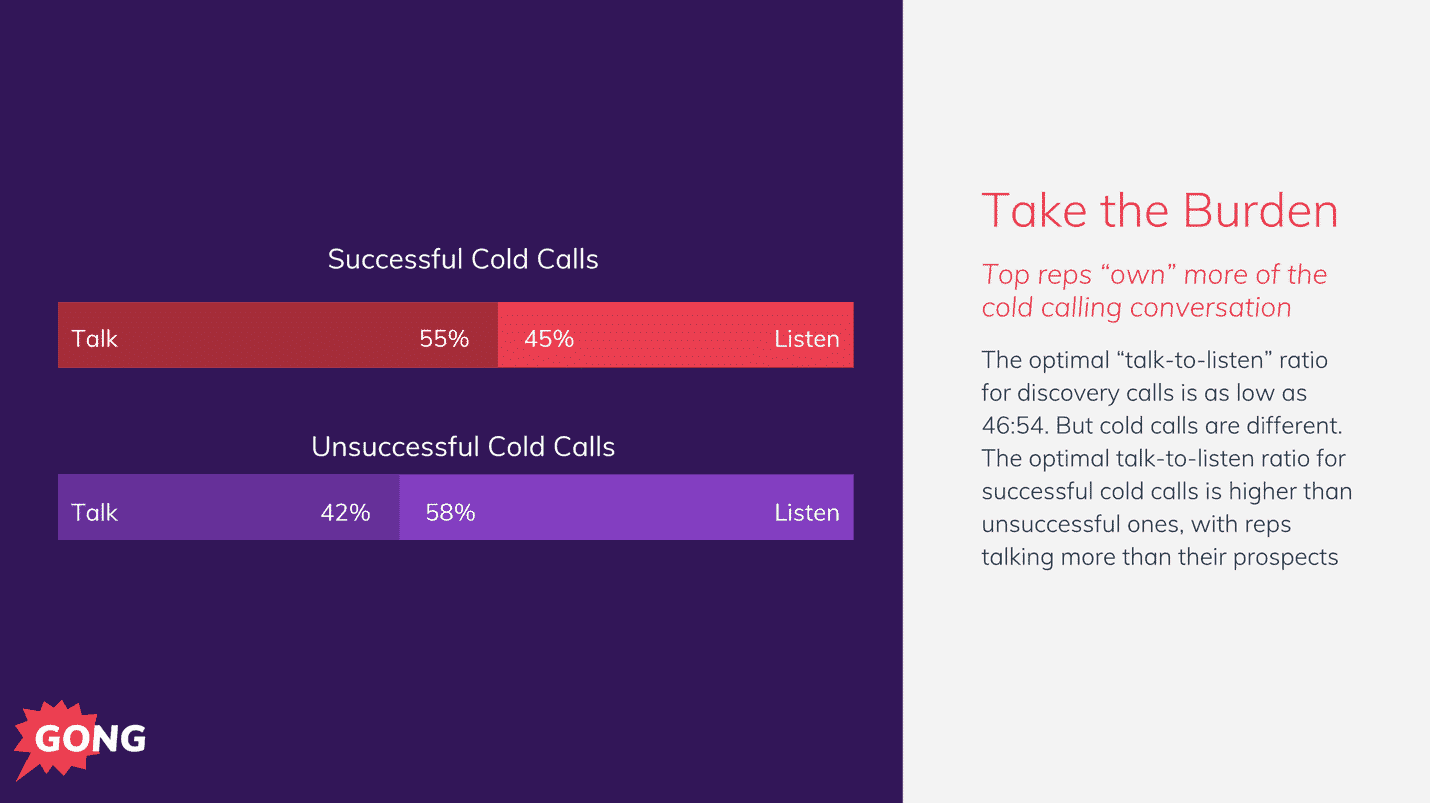
Your job is to sell the “why they should attend the meeting” to your interviewee. You can start by asking about their “top strategic priorities” when booking the meeting. Have you ever tried asking “What are your top priorities…” at the beginning of a sales call? You probably didn’t get much of a response. Focus on selling the meeting, not asking an in-depth question that your sales manager would be proud of.
6. Talking about a competitor: the pitch
If you have followed the previous tips, you have secured a platform to make your pitch: it is time to sell the meeting. Successful cold calls almost always involve making such a pitch:
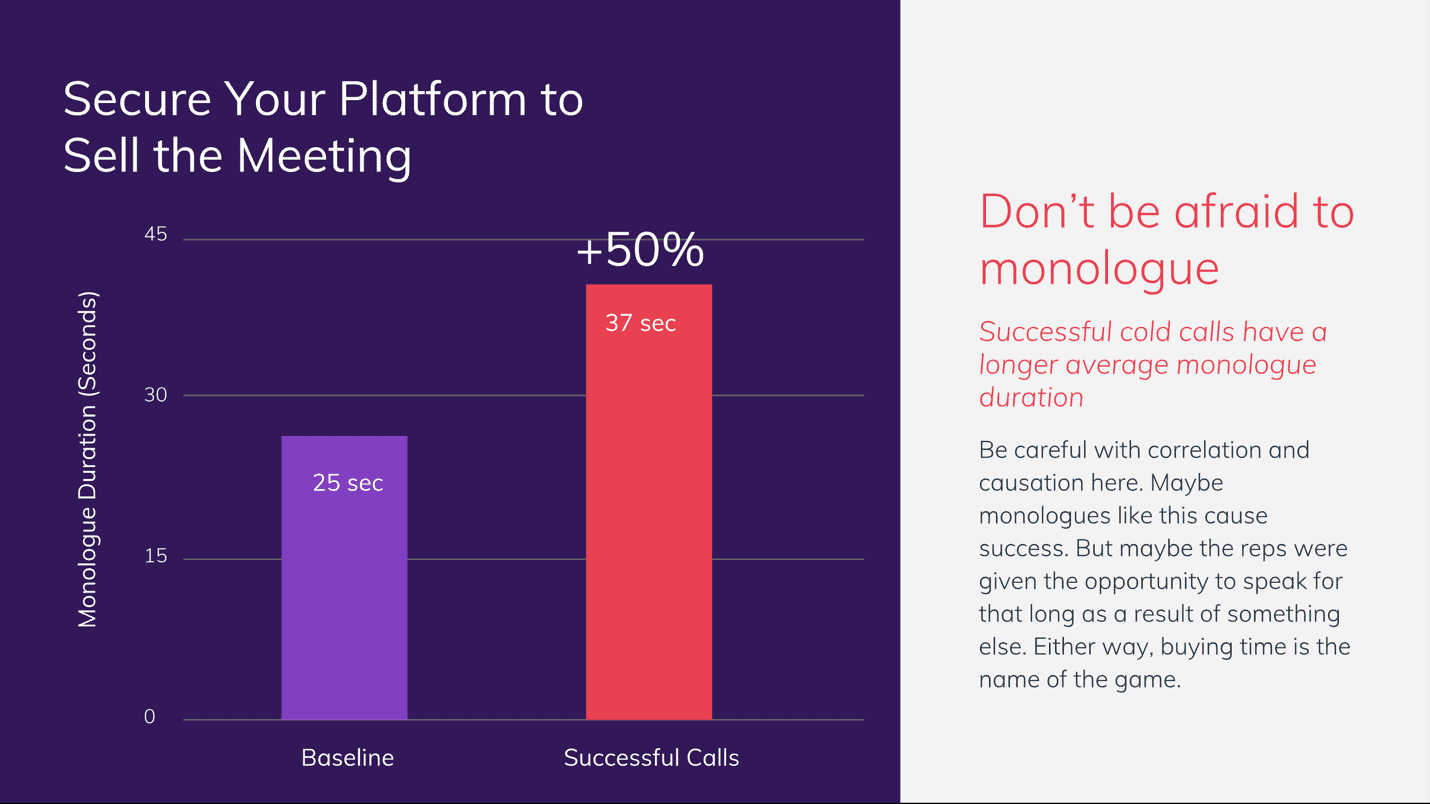
“Pitch” seems to be a forbidden word in sales today. But there is a time and place for that. So what to say during the cold call? You have to sell THE REUNION.
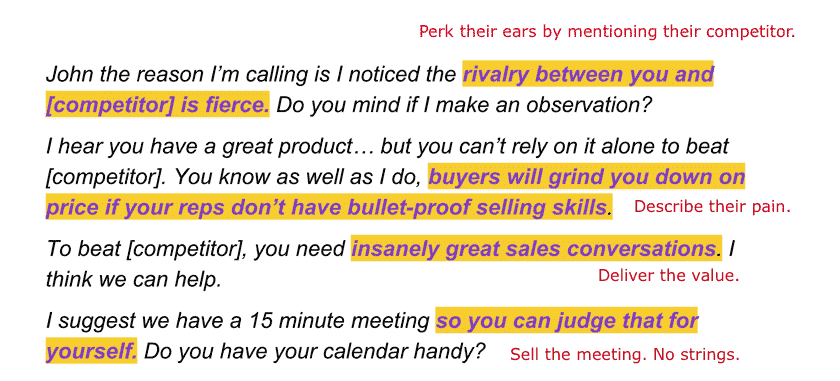
Let’s break this down. If you talk about their competitor, you are sure to get a sympathetic ear. Then just highlight their main pain points. That alone sells the meeting (they just want to know more). To top it all off, you can end with the famous phrase: … You can judge for yourself. That IS “selling the meeting”. Note that there was no mention of the product/service.
7. Don’t be afraid to speak up
We’ve covered a lot of tips to help you as a sales rep. So what should be going on in your prospect’s mind? The average length of a prospect monologue (how long you can get the prospect to talk without interruption) in successful cold calls is only 3.5 seconds. In the case of unsuccessful cold calls, the duration is 8 seconds:
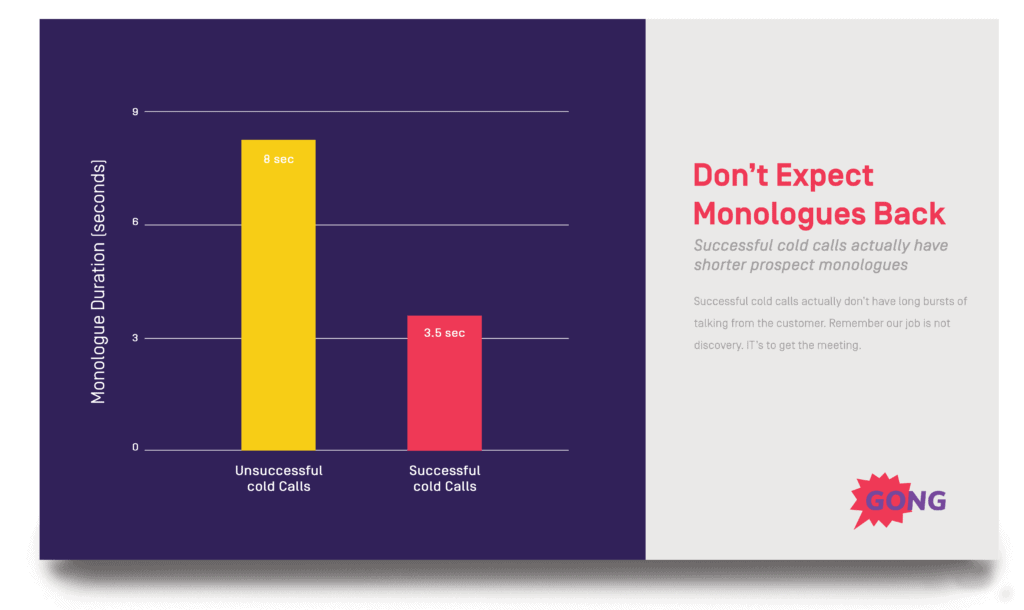
As we mentioned earlier, the job of a cold call is to sell the meeting. And to make a good pitch, a few judiciously placed sales qualifying questions could help engage your potential client. The research you’ll have done before the call combined with a few economic questions is your best bet.
8. Set the pace for your call
A strong sign that a cold call is going well (and that you have asked good discovery questions) is the pace of your discussion. While your cold call will likely start with a few monologues, the verbal back-and-forth between you and your prospect should gradually accelerate as the call progresses. In other words, effective cold calls start as a pitch and slowly evolve into a dialogue. In successful cold calls, there are 77% more speaker changes per minute than those that fail:
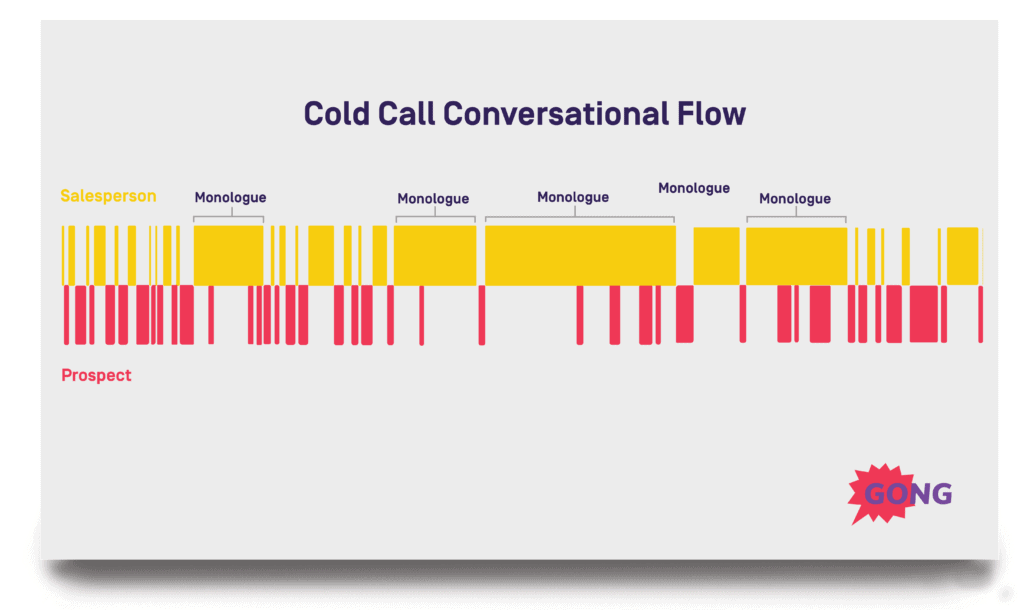
Here you know that you have interested the customer enough (in a very short time) for them to engage you in a dialogue. They have questions that you will have to answer. You have to overcome the objections.
9. Use inclusive vocabulary
You should not use “I”, especially when speaking on behalf of a team. When you first contact a potential client, think of yourself as the biggest “player” on the team. Cold calls that include inclusive language are generally more likely to result in follow-up. Take the example of “we” versus “I”.
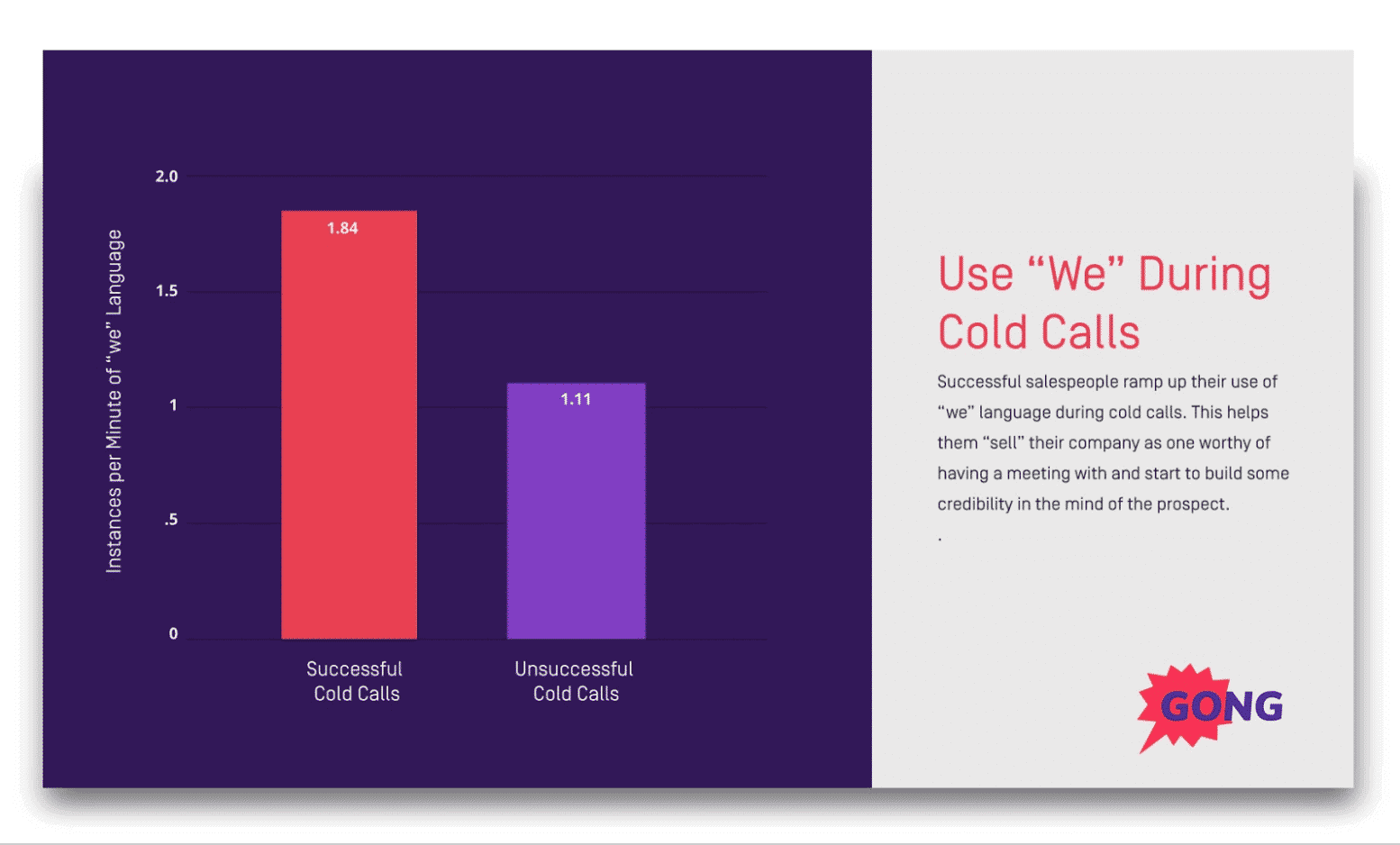
On average, the We/I ratio (or the number of times “We” is used in a call divided by the number of times “I” is used) is 35% higher in successful cold calls than in unsuccessful calls. The same can be said for “our” versus “my”. According to Gong.io’s analysis, the Our-Mon ratio (or the number of times “our” is used for a call divided by the number of times “my” is used) is 55% higher in successful cold calls. In addition to “we” and “our”, successful conversations also incorporated inclusive words like “ourselves”.


